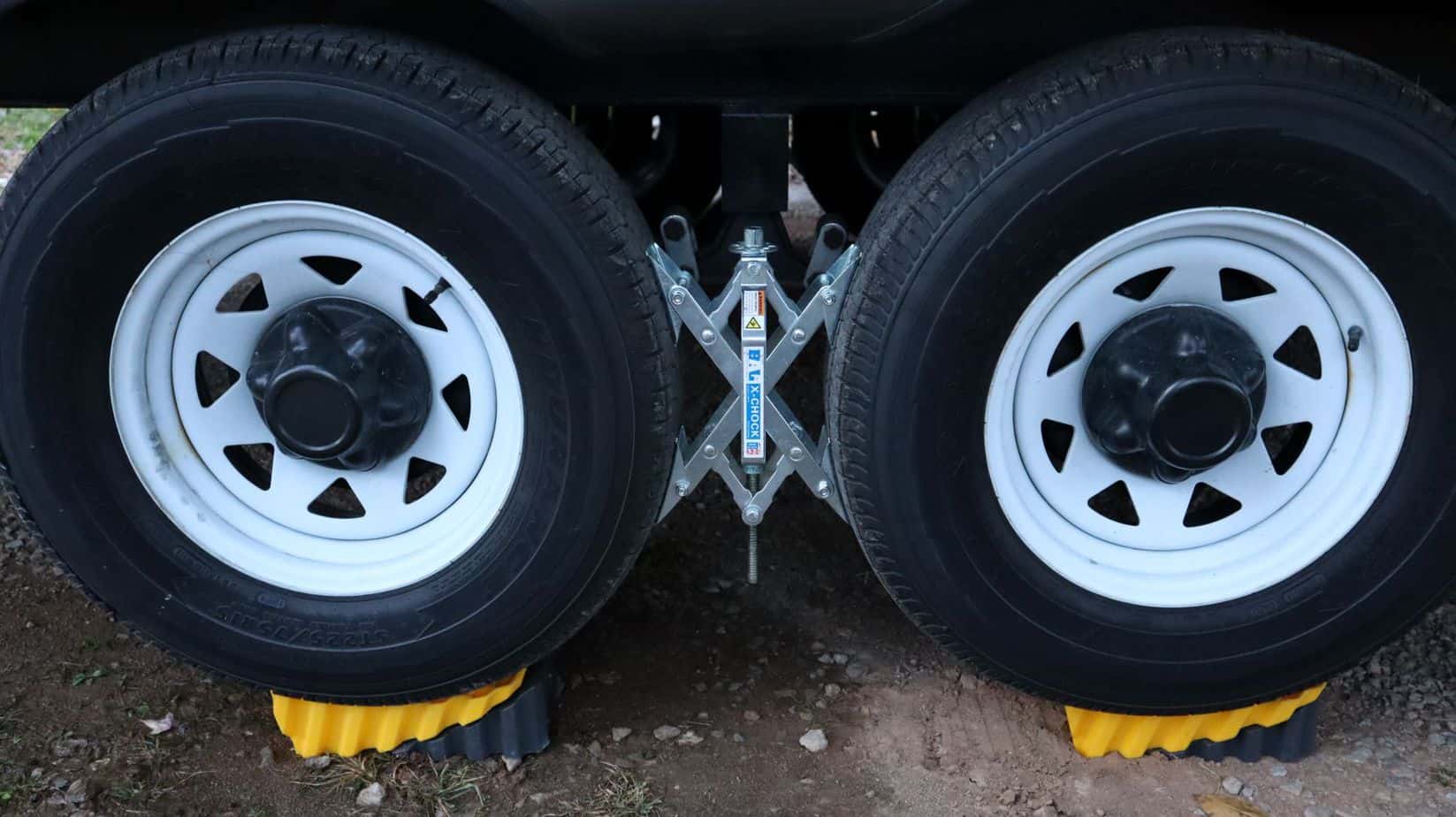One of the most important things to learn as an RV camper owner is to level your setup no matter where you find yourself camping.
Learning the leveling process – starting from left to right, then working front to back, and dialing things in with the right tools – makes a world of difference. Best of all, it doesn’t take very long to learn how to level your RV camper. Mastering this process from beginning to end will only take a few tries!
Below we run through the entire RV leveling protocol, giving you a quick checklist of steps to move through to get your camper leveled off in no time.
Don’t forget to check out our Recommended RV Equipment list!
Let’s jump right in.
Why Level Your Camper?
Many new RV camper owners are surprised to learn how important leveling is.
Many of them (for obvious reasons) would never have considered this to be a huge part of responsible RV operation. Most would have just assumed that “good enough” at any approved RV campsite was just fine.
Nothing could be further from the truth, though.
Without leveling your RV camper, simple things can become a nightmare – from preparing meals on your countertops to cooking, washing, and even sleeping in your RV.
On top of that, an RV that hasn’t been leveled may present a bit of a safety issue. And that’s not something you want to worry about at all.
Improperly leveled RVs can throw off critical sensors, cause your refrigerator or freezer to open (even just so slightly), lead to spoilage, and even help gravity pull your RV away from your parking spot!
No, it’s crucial that you not only learn how to level but that you practice this every single time you park your rig.
Tools You’ll Need to Level an RV Camper.
The good news is you’re not going to need many special tools to level your RV camper.
The overwhelming majority of RVs already have all the tools you need to level on board. And if you do need a couple of extra tools to get the job done, you can pick them up for next to nothing (and may already have them lying around the house or shop).
All you need to level an RV camper are:
- A bubble level (ideally a couple of them in a variety of sizes, it’s even better if one or two are magnetic)
- Leveling blocks specifically designed to be used with RV campers
- Wheel chocks (a huge piece of the puzzle that you don’t want to skip over)
… As long as you have that gear on hand (none of it will take up much space in your RV camper), you’ll be able to level things off in record time.
How to Level Your RV Camper
Now that we’ve covered the basics of why you want to level your RV camper and the tools you’ll need to get the job done, let’s get into the meat and potatoes of how to level your camper quickly, consistently, and reliably!
Level from Left to Right
You first want to level your camper from left to right (starboard side to portside).
This is the easiest part of the level project to pull off, as you’ll be able to level from left to right using the specifically designed blocks we mentioned a moment ago.
These blocks (usually made out of some high density, extremely strong plastic or synthetic materials) can be stacked on top of one another like Legos jack your vehicle up and give you that level stance.
Left to right level also guarantees that you step up into an RV that feels comfortable and an RV that isn’t going to throw your internal equilibrium all over the place.
Chock Your Wheels
You must chock your wheels after getting your blocks into place (deciding which tires need to be raised).
Chock blocks are super affordable (some campers come with them). They are the perfect nonpermanent solution to cement your RV in place once you have it leveled left to right.
You won’t have to worry about your RV scooting all over the place. You won’t have to worry about your RV “settling” somewhere else. The chock blocks are basically land anchors that keep your RV in the exact position you put it.
Drop Your Hitch
Only after your wheels have been shocked should you drop your hitch and release your RV camper from your vehicle.
The only leveling you’re going to do now is leveling from front to back, which can be done entirely independently of the RV camper’s wheel positioning.
Ensure that your chock blocks are secured BEFORE you release your RV camper from the hitch.
Skip that step, and you’ll have to re-hook up, readjust, and then chockablock things, only start the process all over again.
Level from Front to Back
Now you’ll need to level the RV from front to back – and that’s where your magnetic bubble levels are really going to come into play.
Set the levels up on long, straight runs of your RV (maybe even your countertop inside) and then level from front to back until everything is as good.
You can usually adjust things by either raising or lowering the “landing jack” or the “A-frame jack.” You might want to use some of the blocks we mentioned a moment ago to secure those lifts or lowers into place, too.
Stabilize the RV
After all of that has been taken care of and you are pretty happy with the level situation with your RV camper, you want to make sure everything is stable.
Spend a little bit of time walking around inside your RV, ensuring that things don’t shift and move.
You don’t have to go crazy (there’s no reason to turn your RV camper into a human rock tumbler), but you want to jiggle things a little bit to guarantee that your camper isn’t going anywhere.
Closing Thoughts
There you have it – a step-by-step guide for figuring out how to level your RV camper without a lot of headaches, without a lot of hassle, and definitely without a lot of frustration.
Follow the steps we highlighted above, trust in your level, and you’ll be good to go!
Don’t forget to check out our Recommended RV Equipment list!
Get a FREE copy of the Go Together Go Far Travel Trailer Hookup and Disconnect Checklist when you sign up for the Go Together Go Far Newsletter!
Want to learn more about different types of RVs? Check out:
- Best Off-Road Camper Trailer Under $10,000
- Best Bunkhouse Travel Trailer Under 30 Feet
- Are Lance Travel Trailers Any Good?
- Do Rope Lights Deter Rodents?
- What Are the Best Names in the RV Industry?
- 3 Best Travel Trailers for Family of Four
- Blue Ox SwayPro Basics: Top Questions Answered
- Adding A Washer Dryer To Travel Trailer? What You Need To Know.
- Best Drone For Camping, Backpacking, and RVing: A Complete Guide to Drones for RVers
- Furniture and RVs – How To Get It Through the Door…
- How To Get Rid Of A Poop Pyramid In RV Black Tank
- Do You Know How Long To Keep Fresh Water In RV Tank Storage?
- What Is The Best Outdoor Security Camera System For Your RV?
- RV Bumper Mount Grills: 5 Best Options For Your RV Or Camper
- Best Electric Tankless Water Heater for Your RV. What You Need To Know
- Read Before You Buy! How to Find the Best Scooter for RV Camping
- 3 Best Travel Trailers for Family of Four
- Top RV Brands: What Are the Best Names in the RV Industry?
- Lance Campers: What Makes Them So Different?
- Best Bunkhouse Travel Trailer Under 30 Feet
- Best Off-Road Camper Trailer Under $10,000
- Best Weight Distribution Hitch With Sway Control For Travel Trailers in 2022
- What Are The Best Built Travel Trailers? Things To Consider.
- How Does An RV Refrigerator Work? A Quick Guide.
- Why Does My RV Carbon Monoxide Detector Keep Beeping? A Quick Guide.
- Where Is The Power Converter In My RV Or Travel Trailer
- What is the Best Generator for 50 Amp RV?
- Wireless RV Security Camera Systems: Is Solar Powered Security Without Wi-Fi An Option?
- Best Portable Air Conditioner for Camping for 2022
- How to Find the Best 3500 Watt Inverter Generator for RV Camping
- Best Propane Generator For Your RV: Read This Before You Buy!


